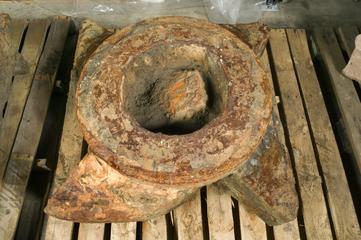

Pressure gauge (bourdon type), made by John Musgrave and Sons Ltd, Bolton, 1881-1912.
John Musgrave & Sons was established in 1850 as the successor company to Musgrave, Son and Heaton. It became a limited company, John Musgrave & Sons Ltd, in 1881. John Musgrave & Sons developed and manufactured horizontal stationary steam engines for collieries, pumping stations, and textile mills. Their products sold around the world. The company was based at the Globe Ironworks in Bolton until the company went into liquidation in 1911.
The Bourdon type pressure gauge was pivotal in accurately measuring pressure. It made steam boilers much safer, making it possible for operators to monitor pressure and avoid accidents and deaths from boiler explosions. First invented in 1849, the guage was widely adopted for monitoring steam boilers in industrial Lancashire. Bourdon's patent rights ended in 1875 and the gauge type was widely manufactured.
The bourdon type gauge is simple but accurate, and is still widely used. A bourdon tube gauge measures pressure by using a curved metal tube that uncurls under pressure and shows the reading on a dial.
Details
- Category:
- Motive Power
- Object Number:
- Y7000.3329
- Measurements:
-
Overall: 54 mm x 334 mm x 320 mm, 4.3 kg
- type:
- gauge




